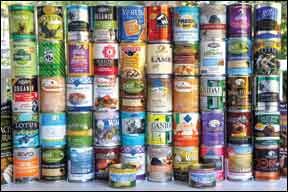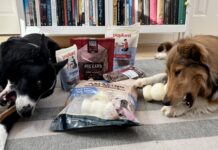Wet dog food is much more “natural” for dogs to eat than dry kibble. Its moisture content is closer to that of meats, eggs, fruits, and vegetables – the sort of things that canines have eaten for the tens of thousands of years before commercial dog foods were invented. Wet foods usually contain more animal protein – the optimum base of a carnivore’s diet – than even very high-quality dry foods. Even the varieties that are formulated with grain – not at all what dogs have eaten as they evolved – contain far less grain than dry foods.

Pound for pound, wet dog food is also more expensive to feed (especially large dogs) than dry foods. That’s because, with its high moisture content, the food is less “energy dense” than dry foods; you have to feed a larger volume of it to give your dog the calories and nutrients he needs. All that moisture is expensive to package and ship.
But the benefits of wet food are many. It’s therapeutic for dogs with kidney ailments, or any disorder that worsens if a dog gets dehydrated. Wet foods are generally far more palatable than dry foods, which can be a literal lifesaver when feeding very thin, sick, or picky dogs. Most dogs digest high-quality wet foods with fewer problems (gas, vomiting, and diarrhea) than dry foods. Wet foods also tend to be far less adulterated with synthetic ingredients than dry foods; artificial colors and flavors are rare in wet foods. And preservatives are not added to canned or pouched foods, since the oxygen-free packaging maintains their freshness. Even without preservatives, wet foods retain their nutrient value far longer than dry foods – two years or more.
WDJ’s Selection Criteria
Because of all of these benefits, some holistic veterinarians are of the opinion that even a lower-quality wet food is healthier than good-quality dry foods.
We won’t go that far, because we like to see high-quality ingredients used in any food that’s fed to our canine companions. Not because we like to imagine that’s what we’d like to eat – the “humanization” marketing ploy – but because we know that diets comprised of a variety of locally sourced, fresh, unprocessed or lightly processed, unadulterated “real food” ingredients are healthiest for any living organism.
How do we determine whether a wet food contains these high-quality ingredients? There are two places on a product label we pay attention to: the ingredients panel and the “guaranteed analysis.” These sections of the label are required by law and tend to be subject to closer review and regulation by state feed control officials than the rest of the package.
We pay no attention to the pictures of the sort of ingredients that are purportedly in the food; they are almost never included in the form depicted on the label.
When looking at the ingredients list, we look for the following (these things are good):
WHOLE MEAT, FISH, OR POULTRY AS THE FIRST INGREDIENT. This means that by weight, there is more of this ingredient than anything else in the food. Wet foods are generally around 78 percent to 82 percent moisture.
There are some good wet foods with water (or broth) first on our “approved foods” list (starting on page 6), but since fresh meat is so high in moisture, most top-notch foods feature an animal protein (fresh meat) first on the list, and water or broth (required for processing) in the second or third position. The point is to look for products that contain as much meat as possible.
There has been a resurgence of popularity of complete and balanced wet foods that contain nothing but meat, water, and a vitamin/mineral supplement; many of these are labeled with a “95% meat” claim. Remember: while some dogs benefit from the inclusion of some carbohydrates in their diets, dogs have no dietary requirement for carbohydrates! They can thrive on diets that contain only protein and fat.
IF GRAINS OR VEGETABLES ARE USED, WE LOOK FOR THE USE OF WHOLE GRAINS AND VEGETABLES. This means we prefer foods that contain “rice” rather than rice flour, rice bran, brewer’s rice, etc. Also, if grains are used in a wet product, we don’t want to see a lot of them! Even a product with an animal protein first on its ingredients list may contain more grain than meat if it has several grains or grain “fragments” on the label, too.
THE WORDS “COMPLETE AND BALANCED” SHOULD APPEAR ON THE LABEL. Some manufacturers produce a few wet food products that are meant for “supplemental or intermittent” use only. These products do not meet the specifications for a “complete and balanced diet” as defined by the model regulations developed by the Association of American Feed Control Officials (AAFCO) and adopted by each state. While these “supplemental” foods may be useful as part of a varied diet, they can’t be relied on to provide all the nutrients your dog needs.
There are also a number of things we look out for – attributes that would cause us to reject a wet food product (these things are bad):
PROTEINS OR FATS THAT ARE NOT IDENTIFIED BY SPECIES. “Animal fat” and “meat proteins” are euphemisms for low-quality, ingredients of uncertain origin.
MEAT BY-PRODUCTS OR POULTRY BY-PRODUCTS. There is a wide range in the quality and type of by-products that are available to pet food producers. And there is no way for the average dog owner (or anyone else) to find out, beyond a shadow of a doubt, whether the by-products used are kept clean, chilled, and used fresh within a day or two of slaughter (as some companies have told us), or are comprised of ingredients that were literally swept off a floor, dumped down the floor drains at the processing plant, and kept for hours or days on unrefrigerated loading docks and trucks.
In recent years, we’ve learned that there is far more variation than we knew in the quality of even named, “whole” meats used in pet foods – the ingredients we’ve described for years as ideal. We were under the impression that whole, named meats were far too expensive to be handled in anything less than a similar fashion to meats meant for human consumption (the legal description is “edible”). We were wrong; we learned this when we had a chance to tour a raw ingredient (meat) plant. We’ll discuss this more in our review of dry foods (in our February 2012 issue). But in the meantime, all we can say is that the whole, named meats tend to be of higher quality and are more likely be maintained in a clean, chilled state prior to processing.
WHEAT GLUTEN. Wet foods often contain some sort of thickener or binder. Various types of “gum” (such as guar gum, from the seed of the guar plant, and carrageenan gum, from seaweed) are common thickeners. Whole grains, potatoes, and sweet potatoes also can be used to thicken wet food. But wheat gluten (and some other glutens) are generally only used in wet foods to hold together artificially formed “chunks” meant to resemble chunks of meat – you know, those perfect cubes of meaty mush found in low-cost dog foods?
If chunks of meat are present in a wet dog food, they should be actual chunks of meat.
SUGAR OR OTHER SWEETENERS. A food that contains quality meats shouldn’t need additional palatants to entice dogs.
ARTIFICIAL COLORS, FLAVORS, or ADDED PRESERVATIVES. Fortunately, these are rare in wet foods!
Other Ingredients
Some ominous-sounding chemicals in a dog food turn out to be a source of a needed vitamin or mineral. Generally, all the vitamins and minerals on a good label are grouped together at the end of the ingredients list. If an ingredient appears after the vitamins and minerals, it’s just “window dressing” – present in the food in a completely insignificant amount.
What about products that contain a long, long list of vegetables and herbs and nutraceuticals? They make a food sound so appealing! Just keep in mind that the more of all this stuff there is in a food, the less room there is for meat – the main reason to feed a wet food.
Let’s Talk About Pet Food Manufacturing Sites
Since the infamous recalls of 2007, we have required any pet food company that wanted its products considered for our approval to disclose their manufacturing sites. Having this information can vastly reduce the panic and uncertainty a dog owner may experience upon hearing of a pet food recall stemming from a certain pet food manufacturing facility; you would know immediately whether your dog’s food was involved or not.
Not all pet food companies will disclose this information, however. Many fear that if any product made at that plant is recalled, their own foods will be “brushed” with the same tar reserved for the recalled products, even if their ingredients are procured and stored separately, and the production lines are well cleaned between their own manufacturing runs and those for other companies’ products. These are valid concerns. There are pet owners who, since the 2007 recalls of melamine-contaminated foods, have refused to buy anything that came out of a Menu plant (that’s the company that manufactured most – not all – of the recalled foods). (Note: those plants are now owned and operated by Simmons Pet Food, North America’s largest wet pet food private-label and contract manufacturer. Some of 2007’s recalled foods were manufactured at American Nutrition Inc.)
We’ve heard all sorts of reports of alleged misconduct at Evanger’s Dog & Cat Food Company. We’re also aware of a serious recall of foods made by Merrick Pet Care (in 2004).
You’ll notice that these three manufacturers (with 7 facilities among them) are responsible for making most of the products on our approved foods list; they are also responsible for making almost all of the high-quality wet pet food in this country. The fact is, there are fewer than a dozen “contract manufacturers” (also known as co-packers) in this whole country that manufacture wet pet food for companies that don’t own and operate their own plants. (All the corporate giants have their own plants.)
No matter where a product is made, preventing the production of a product that will cause a recall requires the procurement and management of top-quality ingredients, good manufacturing practices, and scrupulous oversight and auditing of the manufacturing process. It’s far more effective to ask a pet food company about what it does to accomplish those tasks than it is to blacklist every product made in any facility that ever had a recalled food. With the exception of the brand-new plant launched by Lotus Pet Foods this year, we’re not sure there are any other plants with a perfectly clean record.
Finally, speaking of Lotus, we recently toured its facility and observed the production of a batch of its food. An article describing exactly how wet pet food is made (and photos of the process) appears on the WDJ website.
The Approved Canned Food List
Below is our list of “approved wet foods” for 2011. All of these products have met our selection criteria and the company whose name is on the label has disclosed its manufacturer/s. There are probably more products that both meet our criteria (as described above) and whose makers would answer your questions about their manufacturers. Rest assured that any food that you find that meets our selection criteria is just as good as any of the foods on our list.
We’ve listed the foods alphabetically by company name.
Some companies make several lines of food. We’ve listed each line that meets our selection criteria. We’ve also highlighted one variety from each company as a representative product, to show what sort of ingredients and macro-nutrient levels (protein, fat, fiber, and moisture) are typically found in that maker’s foods. Rather than try to list all the ingredients in each food we highlight, we’ve listed the first 10 ingredients – the major components of the food.
Remember, quality comes with a price. These foods may be expensive and can be difficult to find, depending on your location.






